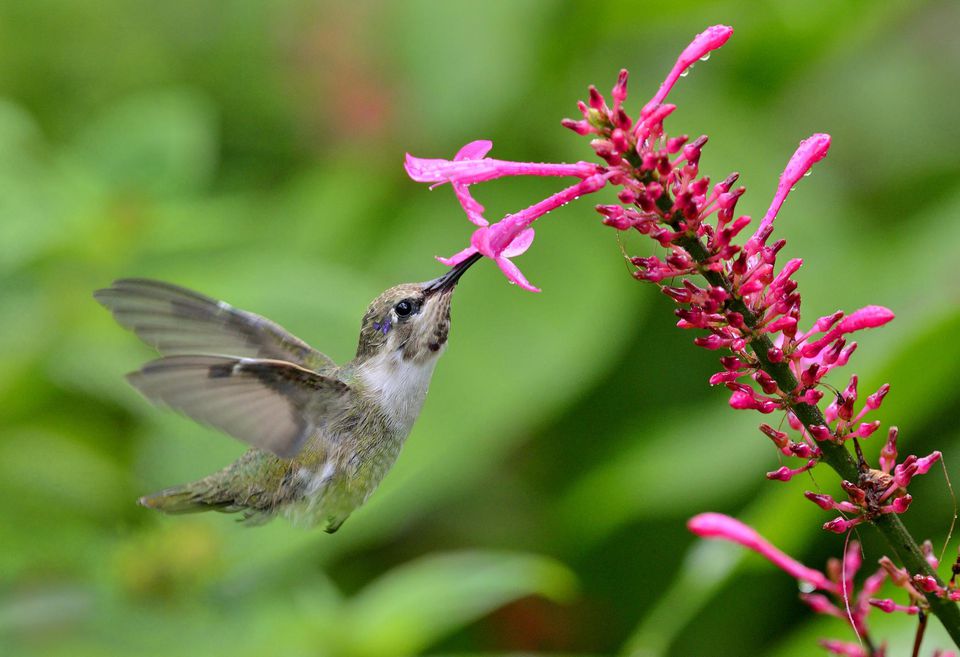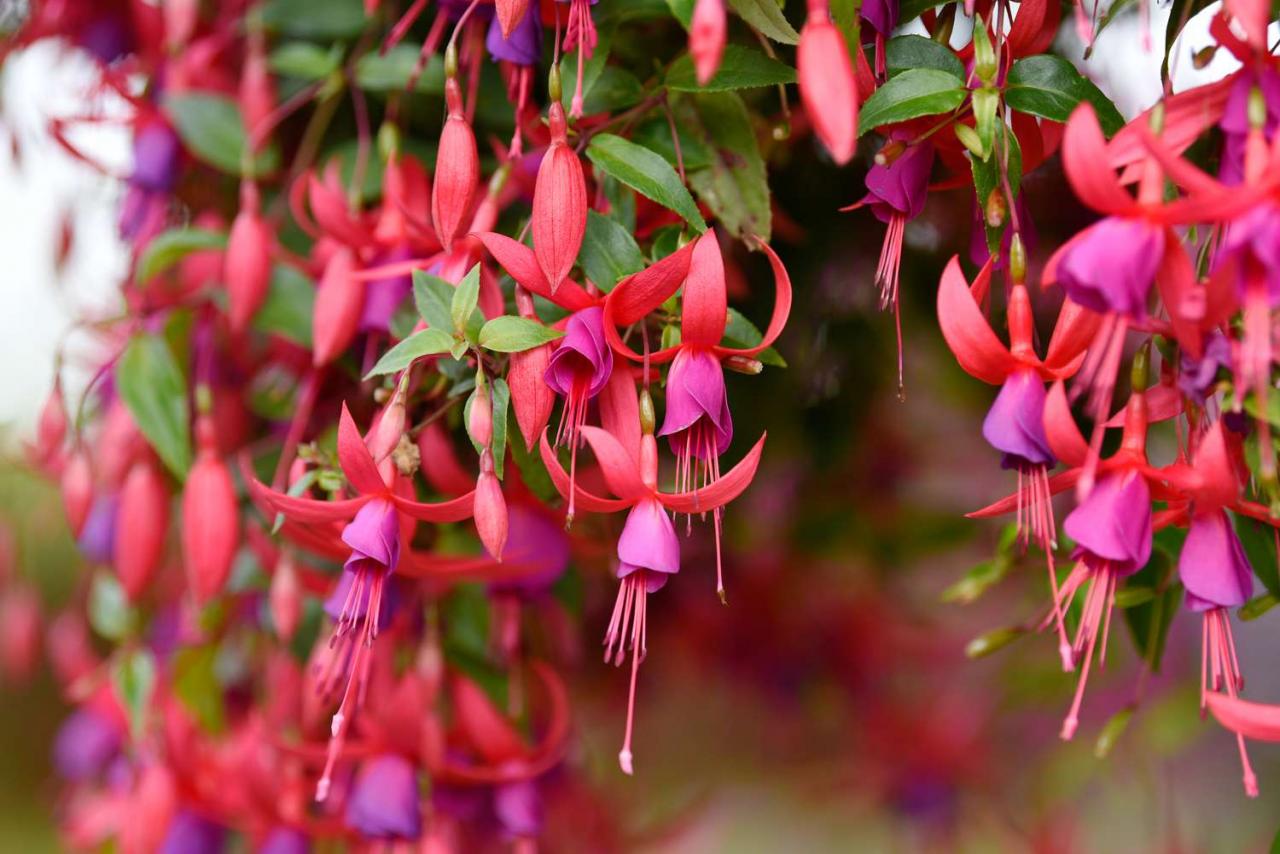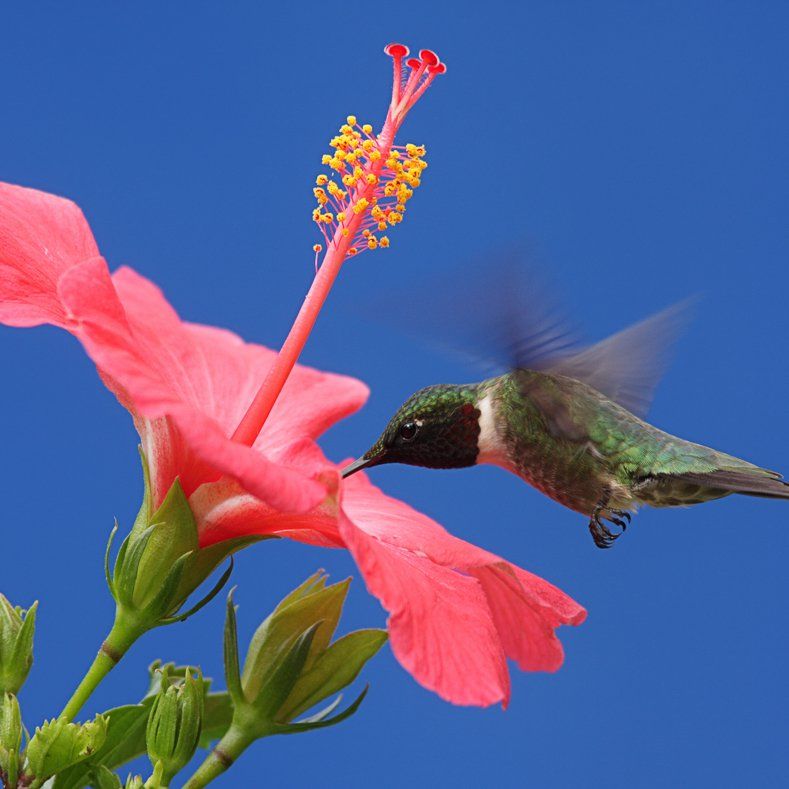Attracting hummingbirds to your home garden with flowers is more than just a pretty picture; it’s a journey into the fascinating world of these tiny, energetic creatures. Learn how to transform your outdoor space into a vibrant hummingbird haven, attracting these dazzling birds with the right blooms and garden design. From understanding their preferences for nectar-rich flowers to creating a safe and inviting environment, we’ll guide you through every step.
Get ready to witness the magic of hummingbirds up close!
This guide delves into the art of attracting hummingbirds, covering everything from selecting the perfect flowers—considering color, shape, and size—to designing a garden layout that maximizes their appeal. We’ll explore the differences between annuals and perennials, offer practical tips on garden maintenance, and address potential challenges like pest control and predator protection. By following these simple steps, you can create a thriving hummingbird habitat in your own backyard, enjoying the beauty and wonder of these captivating creatures.
Understanding Hummingbird Preferences

Attracting hummingbirds to your garden is a rewarding experience, but understanding their preferences is key to success. These tiny, energetic birds are highly selective about their food sources, focusing on flowers that offer the most efficient and nutritious nectar. Their choices are driven by a combination of visual cues, flower shape, and the accessibility of the nectar itself.
Hummingbirds are primarily attracted to flowers that provide a readily available source of high-energy nectar. They prioritize flowers with characteristics that make foraging easy and efficient, minimizing energy expenditure during their busy day of feeding and defending territory. This efficiency is crucial for their high metabolism.
Flower Characteristics Attractive to Hummingbirds
Hummingbirds are drawn to specific floral traits. The color, shape, and size of a flower all play a significant role in attracting these nectar-loving creatures. A vibrant display isn’t enough; the flower must also be structurally suitable for the hummingbird’s unique feeding style.
Hummingbird-Attracting Flower Types
The following table showcases examples of flowers known to attract hummingbirds. Remember, the success of attracting hummingbirds also depends on other factors such as the time of year and your local climate.
| Common Name | Scientific Name | Color(s) | Characteristics |
|---|---|---|---|
| Trumpet Honeysuckle | Lonicera sempervirens | Red, Orange | Tubular flowers, fragrant |
| Bee Balm | Monarda spp. | Red, Pink, Purple | Clustered flowers, attractive to bees as well |
| Cardinal Flower | Lobelia cardinalis | Bright Red | Tall spikes of vibrant red flowers |
| Columbine | Aquilegia spp. | Red, Yellow, Pink, Purple | Unique spurred flowers |
The Importance of Flower Color
Bright, vibrant colors, particularly red, orange, and pink, are highly attractive to hummingbirds. While they can see some colors in the ultraviolet spectrum that humans cannot, their visual system is particularly sensitive to these bold hues. These colors stand out against foliage, making them easily detectable during foraging flights. However, it’s important to note that hummingbirds will also visit flowers of other colors, particularly if those flowers offer abundant nectar.
Flower Shape and Size in Hummingbird Feeding
Hummingbirds have long, slender beaks perfectly adapted for accessing nectar from tubular or bell-shaped flowers. The size and shape of the flower are crucial; the flower needs to be long enough to require the hummingbird to hover, but not so long as to make nectar inaccessible. Flowers with a relatively wide opening also tend to be more attractive, as they allow for easier access to the nectar.
Flowers that are too small or too tightly closed will be less appealing to hummingbirds.
Choosing the Right Flowers: Attracting Hummingbirds To Your Home Garden With Flowers

Attracting hummingbirds to your garden is all about providing a buffet of their favorite blooms. Understanding their preferences for color, shape, and scent is key to creating a hummingbird haven. The right flowers will ensure a constant supply of nectar, keeping these dazzling birds buzzing around your space all season long.Choosing the right flowers involves considering bloom times, colors, and the type of plant – annual or perennial.
This ensures a continuous display of nectar-rich blooms throughout the hummingbird season.
Hummingbird-Attracting Flower Species, Attracting hummingbirds to your home garden with flowers
A diverse selection of flowers is crucial to attracting hummingbirds throughout the growing season. Different species bloom at different times, providing a continuous source of food. Here are some excellent choices:
- Bee Balm (Monarda): Blooms summer; Colors range from red, pink, purple, and white.
- Trumpet Honeysuckle (Lonicera): Blooms spring and summer; Offers vibrant red, orange, or yellow tubular flowers.
- Salvia: Blooms summer and fall; Available in various colors including red, purple, blue, and white.
- Columbine (Aquilegia): Blooms spring; Features pendulous flowers in shades of red, yellow, blue, and pink.
- Fuchsia: Blooms summer and fall; Showy, pendulous flowers in red, purple, pink, and white combinations.
- Cardinal Flower (Lobelia cardinalis): Blooms summer; Showy, bright red flowers.
- Zinnia: Blooms summer and fall; Offers a wide array of colors including red, orange, yellow, pink, and white.
- Petunia: Blooms summer and fall; Abundant blooms in various colors.
- Penstemon: Blooms spring and summer; Offers tubular flowers in various colors including red, pink, purple, and white.
- Coral Bells (Heuchera): Blooms spring and summer; Offers delicate bell-shaped flowers in shades of pink, red, and white.
Annual vs. Perennial Hummingbird Flowers
The choice between annuals and perennials depends on your gardening preferences and the level of maintenance you’re willing to undertake.Annuals, like zinnias and petunias, complete their life cycle in one growing season. They provide a burst of color, but need to be replanted each year. The advantage is their quick and vibrant display. The disadvantage is the need for yearly replanting.Perennials, like bee balm and salvia, live for multiple years, returning each spring.
Want to attract hummingbirds to your garden? The key is vibrant, nectar-rich blooms! Choosing the right flowers is crucial, and luckily, there are tons of options. To find the perfect plants for your hummingbird haven, check out this awesome guide on plants for home garden to discover which species will thrive in your area and entice those buzzing beauties.
Remember, the more variety you plant, the more hummingbirds you’ll attract!
They offer long-term beauty and require less frequent planting. However, they may require more establishment time before they reach their full blooming potential. Careful selection of perennials ensures continuous blooms across seasons.
Want to attract hummingbirds to your garden? Bright, tubular flowers are key! To find the perfect hummingbird-attracting plants, head to your local home depot garden centre for a wide selection of vibrant blooms. They’ll have everything you need to create a hummingbird haven, ensuring these tiny jewels visit your garden regularly.
Sample Hummingbird Garden Design
This design incorporates flowers with staggered bloom times for continuous hummingbird activity.
- Early Spring: Columbine (front border), planted near a sunny area.
- Late Spring/Early Summer: Trumpet Honeysuckle (trellis or fence), positioned to receive plenty of sunlight.
- Summer: Bee Balm (middle border), planted in a well-drained area; Salvia (back border), positioned for afternoon sun.
- Late Summer/Fall: Zinnia (pots or containers), placed in a sunny location; Fuchsia (hanging baskets), providing a vertical element.
Hummingbird Feeding Illustration
The image depicts a ruby-throated hummingbird hovering in front of a vibrant red trumpet-shaped flower, such as a salvia. The hummingbird’s long, slender beak is extended deep into the flower’s corolla, delicately sipping nectar. The hummingbird’s iridescent green and ruby-red plumage contrasts beautifully against the bright red of the flower. Delicate details like the hummingbird’s tiny feet clinging to the flower and the fine hairs on its body are visible.
The background is softly blurred, drawing focus to the hummingbird and the flower, creating a sense of motion and natural beauty. The overall impression is one of grace and vibrant color, capturing the essence of the hummingbird’s delicate feeding process.
Garden Design and Placement

Creating a hummingbird haven requires more than just planting pretty flowers; strategic garden design is key to attracting these dazzling birds. The right location and thoughtful layout maximize their chances of discovering, and returning to, your floral feast. Consider sunlight exposure, shelter from wind and predators, and the overall aesthetic appeal to create a truly inviting space.A well-designed hummingbird garden considers the needs of the birds throughout the entire growing season.
Hummingbirds need easy access to food and water, and protection from the elements and potential dangers. By layering your planting and thoughtfully choosing locations, you can create a haven that attracts and supports these tiny acrobats.
Optimal Garden Location
The ideal location for a hummingbird garden receives at least six hours of direct sunlight daily. This ensures the flowers bloom vibrantly and produce ample nectar, the hummingbirds’ primary food source. However, it’s also important to provide some sheltered areas within the garden. A strategically placed shrub or small tree can offer protection from strong winds and potential predators like cats.
Consider the prevailing winds in your area and position your garden accordingly, shielding delicate plants from harsh gusts. A sunny spot near a window, where you can easily observe your feathered friends, is a perfect option.
Layered Garden Design
A layered garden design maximizes the attractiveness of your hummingbird garden throughout the growing season. Think of it like a tiered buffet for hummingbirds. Start with low-growing groundcovers, such as creeping phlox or verbena, at the base. These provide early-season blooms and offer shelter for insects that hummingbirds also consume. Next, add mid-height plants like salvias and bee balm, which offer a variety of nectar sources throughout the summer.
Finally, incorporate taller plants such as cardinal flower or honeysuckle vines, which provide visual interest and nectar later in the season. This layered approach ensures a continuous supply of food for your hummingbird visitors. Imagine a vibrant tapestry of color and height, attracting hummingbirds from spring’s first blooms to the last flowers of autumn.
Planting Hummingbird-Attracting Flowers
Before planting, prepare the soil by loosening it to a depth of about 12 inches. Mix in compost or other organic matter to improve drainage and fertility. This ensures your plants thrive and produce plenty of nectar. When planting, follow the spacing recommendations on the plant labels. Generally, smaller plants can be spaced closer together, while larger plants need more room to grow.
For example, a small patch of columbine might only require 6-12 inches between plants, while a larger perennial like a bee balm might need 18-24 inches. Water thoroughly after planting, and continue to water regularly, especially during dry periods.
Creating a Hummingbird-Friendly Water Source
Hummingbirds need a reliable source of fresh water, not just for drinking, but also for bathing. A simple shallow dish filled with water is insufficient; they prefer moving water. A small birdbath with a gentle trickle or a mister is ideal. Alternatively, you can create a DIY hummingbird water feature using a small pump and a shallow dish.
Position the water source near your flowering plants for easy access, and keep it clean to prevent the spread of diseases. The gentle sound of running water also attracts hummingbirds, adding another layer of appeal to your garden. Consider a small fountain or a repurposed drip irrigation system, ensuring the water is shallow enough for safe bathing and drinking.
The key is to provide a clean and readily accessible water source in close proximity to their food source.
Maintaining a Hummingbird-Friendly Environment

Attracting hummingbirds to your garden is only half the battle; keeping them coming back requires consistent effort in maintaining a welcoming habitat. A hummingbird’s survival depends heavily on a reliable food source, and a thoughtfully managed garden ensures their continued presence throughout the seasons. Neglecting this crucial aspect will result in disappointed birdwatchers and potentially hungry hummingbirds seeking sustenance elsewhere.Providing a continuous supply of nectar is paramount for hummingbird health and survival.
These tiny creatures have incredibly high metabolisms and require frequent feeding. A gap in nectar availability can significantly impact their energy levels and overall well-being, potentially leading to starvation or vulnerability to predators. Therefore, strategic planting and garden maintenance are key to ensuring a constant supply of their favorite food.
Deadheading Spent Flowers for Continuous Bloom
Deadheading, the process of removing spent blossoms, is crucial for encouraging continuous flowering in your hummingbird garden. By removing faded flowers, you prevent the plant from diverting energy into seed production and instead stimulate the growth of new blooms. This simple act ensures a consistent nectar source for your feathered friends. For example, removing the spent flower heads of salvias will encourage the plant to produce more flowers, providing a longer period of nectar availability.
Regular deadheading, ideally every few days, is the most effective way to maintain a vibrant and nectar-rich garden.
Natural Pest Control in a Hummingbird Garden
Hummingbirds are sensitive to pesticides, so employing natural pest control methods is essential for their safety and the health of your garden. Harmful chemicals can directly poison hummingbirds or contaminate their food source. Here are some effective, environmentally friendly alternatives:
- Introduce beneficial insects: Ladybugs, lacewings, and praying mantises are natural predators of many common garden pests like aphids and mealybugs. Their presence can significantly reduce the need for chemical intervention. Imagine a ladybug delicately consuming an aphid on a vibrant fuchsia bloom – a natural and beautiful solution.
- Use insecticidal soap: This organic solution effectively controls many soft-bodied insects without harming beneficial insects or hummingbirds. It’s a safe and effective option for spot treating infestations.
- Employ companion planting: Certain plants repel pests naturally. For instance, planting basil near tomatoes can deter tomato hornworms. Strategic planting can create a balanced ecosystem that minimizes pest problems without harmful chemicals.
- Handpick pests: For small infestations, manually removing pests can be an effective and safe method. This is especially helpful for larger pests that can be easily identified and removed.
Avoiding Harmful Pesticides and Herbicides
The use of chemical pesticides and herbicides poses a significant threat to hummingbirds and the overall health of your garden ecosystem. These chemicals can directly poison hummingbirds through contact or ingestion of contaminated nectar. Furthermore, they disrupt the delicate balance of the garden ecosystem, harming beneficial insects and potentially leading to secondary pest problems. Always opt for organic gardening practices, prioritizing natural pest control methods and weed management techniques.
Choosing plants resistant to common pests and diseases will also minimize the need for chemical interventions. Remember, a healthy, thriving garden is a safe and inviting haven for hummingbirds and other beneficial wildlife.
Additional Considerations

Attracting hummingbirds to your garden is a rewarding experience, but success isn’t guaranteed. Several factors can influence their presence, and understanding these challenges is crucial for creating a truly hummingbird-friendly haven. Beyond choosing the right flowers and designing an appealing garden layout, there are other important aspects to consider for a thriving hummingbird population.
Creating a haven for hummingbirds involves more than just providing a feast of nectar-rich flowers. Potential challenges, like competition and predation, need to be addressed to ensure the hummingbirds feel safe and thrive in your garden. Understanding these factors and taking proactive steps will significantly improve your chances of attracting and supporting these fascinating creatures.
Competition from Other Pollinators and Predators
Hummingbirds aren’t the only creatures drawn to vibrant flowers. Bees, butterflies, and other pollinators will also compete for nectar. While this competition isn’t necessarily detrimental, it can reduce the amount of nectar available for hummingbirds. Planting a diverse range of flowers, including those that attract different pollinators, can mitigate this issue by offering a wider variety of food sources.
Furthermore, predators like cats, snakes, and larger birds pose a significant threat to hummingbirds. Minimizing these risks is vital for creating a safe sanctuary.
Providing a Safe Haven for Hummingbirds
Protecting hummingbirds from predators is essential. Keeping cats indoors, especially during the day when hummingbirds are most active, is crucial. Cats are adept hunters and pose a significant threat to these tiny birds. Similarly, reducing the presence of other predators, such as snakes, can be achieved by maintaining a tidy garden, removing potential hiding places, and using deterrents if necessary.
Providing dense shrubs and trees offers hummingbirds places to escape and rest safely from aerial predators.
Benefits of Planting Native Flowers
Planting native flowers offers numerous advantages for supporting local hummingbird populations. Native plants are naturally adapted to the local climate and soil conditions, requiring less maintenance and water. More importantly, they provide a crucial food source for hummingbirds, ensuring they have access to nectar that is familiar and easily accessible. Native plants also support the entire ecosystem, providing habitat and food for other beneficial insects and animals, creating a healthier and more balanced garden environment.
For example, choosing native salvias, bee balms, and trumpet honeysuckles will attract hummingbirds accustomed to these nectar sources.
Checklist for Attracting Hummingbirds
Successfully attracting hummingbirds requires a multi-faceted approach. The following checklist summarizes the essential steps, categorized for clarity and ease of implementation.
| Step | Action |
|---|---|
| Research Local Hummingbird Species | Identify the hummingbird species prevalent in your region to select appropriate flowers and understand their specific needs. |
| Select Nectar-Rich Flowers | Choose a variety of flowers with tubular shapes and bright colors, blooming at different times throughout the season. Consider both annuals and perennials for continuous blooms. |
| Create a Safe Environment | Keep cats indoors, minimize the presence of other predators, and provide dense vegetation for shelter. |
| Provide a Water Source | Offer a shallow dish of water or a hummingbird bath for drinking and bathing. Regular cleaning is essential. |
| Avoid Pesticides | Use organic gardening methods to protect hummingbirds and other beneficial insects. |
| Maintain the Garden | Regularly deadhead spent flowers to encourage continuous blooming and remove weeds that compete for resources. |